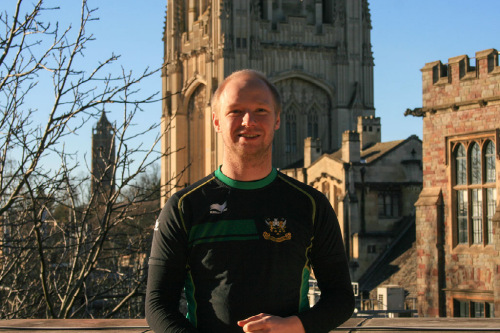Current designs rely on cameras which track a ball’s trajectory to check if it crossed the line.
But the new patent, developed by University of Bristol research engineer Patrick Sullivan and University of Bristol philosopher Dr Mo Abolkheir, would use electroconductive materials such as nickel, silver or graphene instead.
This would be particularly useful in rugby when mauls obscure the cameras’ view of the ball, making it difficult to prove if a try has been scored.
However, the novel system could also be used in other sports such as football and athletics, and for performance analysis and refereeing.
After two and a half years of work, the project has resulted in a GB patent, a pending international patent and a soon-to-be new company developing the technology.
Lifelong rugby fan Patrick had dreamt of being an inventor since he was a child.
Now 25 and studying for an engineering doctorate, he said: “When I was 11 one of my dad’s closest friends told me ‘you can’t be an inventor but you can be an engineer, which is almost the same thing’.
“I used to design stuff all the time back then. My first idea for a single item dishwasher was never going to happen, nor was my wind turbine-powered car, but while on my engineering undergraduate at Bristol University I finally hit on one that could work.
“This invention could compete with and even replace current technologies used in football, tennis, rugby and more. It will be great to add something to the sports that I’ve spent so many years following.”
Patrick captained his school rugby team and still plays for a local Bristol side. But watching games on TV he was always frustrated by the uncertainty of decisions made by TMO, or the Television Match Official.
That’s when he met Dr Mo Abolkheir, an honorary philosopher of inventions and patents at the University of Bristol, who had begun mulling the problem over himself after watching a debatable decision at the Principality Stadium in Cardiff.
Dr Abolkheir showed Patrick his Half-Causation Method, which provides a framework for developing inventions and getting them patented.
Using this method and Patrick’s idea, the pair developed patent 2588495, a ‘Positional detection system’.
Patrick and Dr Abolkheir are joined in their efforts by materials expert Professor Paul Hogg and electronics expert Dr Shyqyri Haxha, both from Royal Holloway, University of London, and investor Paul Andrews, a successful CEO and director of several companies
Dr Abolkheir said: “As a philosopher, it is quite satisfying to see an abstract model being implemented and producing successful practical results.
“As a teacher, it is a genuine pleasure to collaborate with Patrick Sullivan, who exhibited impressive engineering competence even when he was still an undergraduate.
“The team is currently working on further technological developments, with more patents to come: watch this space!”
Now that the patent has been issued, Patrick can relax while watching sport.
“When I was in the pub with mates I had to grit my teeth when decisions were being made by TMO or VAR,” he said. “Now the patent has been issued I can finally tell them about the invention.”
